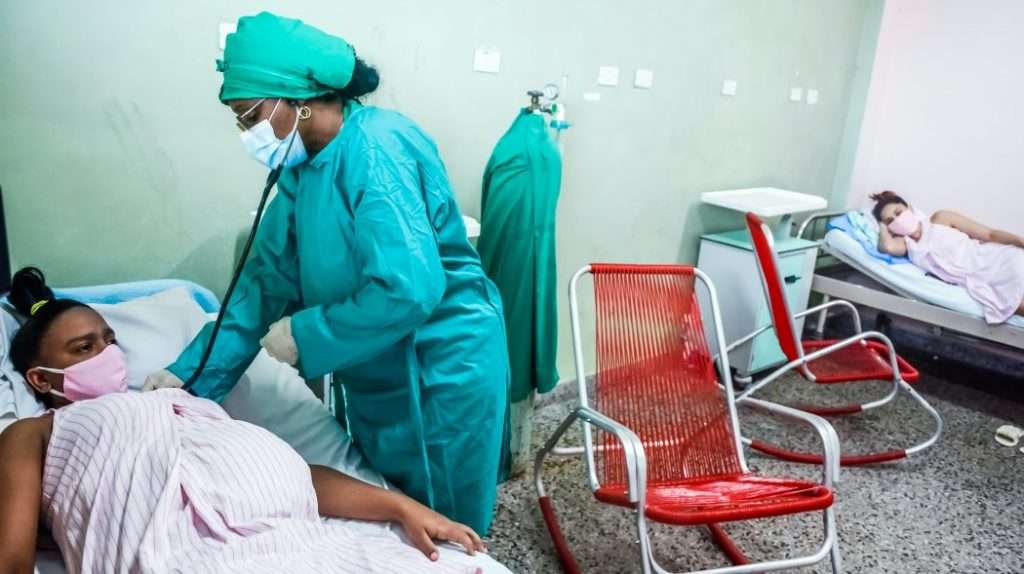The Minister of Public Health of Cuba, José Ángel Portal Miranda, Has expressed bluntly: the number of maternal deaths in the country in recent years is still far from the desired and even expected results. specialists match in which the most evident achievements are reached in infant mortality, but the expected effects are not obtained in maternal mortality. The general trend of the indicator on the island barely changes over time.
For the researcher Maydeé Vázquez, from the Center for Demographic Studies (CEDEM) of the University of Havana, the indicator slowly progresses and resists entering into a process of sustained decline.
After the notable contraction of the figures in the 1980s and 1990s, when rates below 40 per 100,000 live births were achieved, the behavior in the first two decades of the 2000s has tended to stabilize in a average 43.3 per 100,000 live births; or, rather, to the tobacconist.
The numbers imply non-compliance with one of the Millennium Development Goals (MDG) proposed by the United Nations Organization for 2015 and of which Cuba is a signatory.
The fifth of the goals proposed the reduction by three quarters (75%) of the maternal mortality rate of 1990 in the period 1990-2015; implied reaching a rate of 10.5 in 2015 from the reduction of our 1990 statistics (31.6) as was recognized in the Report on Cuba to the XI Regional Conference on Women in Latin America and the Caribbean of the Economic Commission for Latin America and the Caribbean (Cepal).
In 2015, the island recorded 41.6 maternal deaths per 100,000 live births. The goal was not achieved then, and it is not achieved yet.
A parenthesis for the 2021 figures
Cuba closed 2021 with 175 maternal deaths, an unprecedented figure since the 1950s. In 1959 the global maternal mortality rate was 137.8.
The numbers for 2021 surpassed by a wide margin all the records of the revolutionary period and reversed the historical trend towards stability, even in numbers that are not exactly low.
In 2021, 175 pregnant women died in Cuba. According to the official information93 of them died due to pneumonia caused by the new coronavirus and other associated complications.
Although Cuba started in July 2021, the massive vaccination of pregnant and lactating mothers in an attempt to contain, if not the infection, at least the progression of the disease to critical stages and death, it was not possible to prevent the increase in infections. The months of July, August and September showed the highest peaks of infections in pregnant women and also of deaths.
Throughout the year, 6,947 pregnant and postpartum women were diagnosed with the disease.
More than half of the total deaths were registered due to the spread of COVID-19. In this sense, it is undeniable that the impact of the pandemic contributed to the definitive shooting of the numbers.
However, apart from the increase due to the pandemic, the country recorded 82 maternal deaths from causes that were not related to the coronavirus.
The number was equivalent to a mortality rate of more than 80 compared to the 99,093 live births that Cuba had in the previous year. It is inescapable evidence that, in the context of confronting the pandemic, the stress on the health system had a direct reflection on the increase in the loss of pregnant women.
Maternal mortality figures above 80 per year have not been reported on the island for 50 years. Among the fundamental causes —not associated with the pandemic— that influenced the increase in the indicator in 2021 were obstetric hemorrhages and sepsis, in the words of the Minister of Health. Neither of the two causes is new.
At the end of the first semester of the current year, Cuba records a maternal mortality rate of 34.8, according to the health minister. The decline in numbers puts us back in the pre-pandemic statistical range.
Maternal deaths, the endless cycle?
We understand maternal death as the death of a woman while she is pregnant or within 42 days after the end of her pregnancy, due to any cause related to or aggravated by the pregnancy or its management, but not due to accidental or incidental causes. In the medical literature, maternal or obstetric deaths are divided into direct and indirect.
During the last two decades, direct causes of death have prevailed in Cuba. Of the 829 maternal deaths occurred in the period 2005-2018; slightly more than half were due to direct deaths (463), followed by indirect (247) and others (119).
They are highlighted among the main Causes direct causes of death are obstetric haemorrhages, thromboembolic complications and sepsis.
These are, basically, causes that result from complications of pregnancy, childbirth and the puerperium; of interventions, omissions, incorrect treatment or a chain of events originating in any of the aforementioned circumstances. These deaths are, by expert definition, preventable.
The importance of reducing the indicator was reflected in one of MINSAP’s work objectives for the year 2020. Objective 1.6 of the document set as a goal a direct maternal mortality rate of less than 15 per 100,000 live births.
It was breached. And with that, preventable maternal deaths have contributed the most loss of life to the rate. In the last two decades, the indicator has not been less than 20.
In the case of indirect causes, in Cuba these were basically related to affections of the circulatory and respiratory systems of pregnant women.
On the other hand, indirect causes of maternal death are understood to be those that result from an existing disease from before the pregnancy or from a disease that evolves during the pregnancy; direct obstetric causes are excluded, and are considered to be aggravated by the physiological effects of pregnancy.
Reducing the numbers of maternal death in Cuba depends on various factors. Within the health system, in relation to the Maternal and Child Program (PAMI), among the main problems identified The performance of some management cadres and teams and the functioning of the basic work groups in the community scenario, their completion and preparation, which do not always manage to be as efficient as required, are found.
Failures in different links of the Program’s care chain, from the health area to the management cadres, have been identified as factors that threaten the control of maternal and infant mortality.
They also fail to fully comply priorities of PAMI as the use of maternity homes; the guarantee of compliance with hygienic-sanitary standards and procedures that condition the appearance of infections associated with medical care, the occurrence of outbreaks and the solution of structural problems in facilities and care services for pregnant women and babies, to name a few.
However, the reduction in figures does not only depend on the health system. In the Cuban scenario, in addition to the clinical causes, there are social determinants that generate and aggravate the resistance to the decrease in maternal mortality in Cuba.
Historically inherited social asymmetries, as well as unresolved disadvantages weigh on the maternal survival variable, according to Professor Juan Carlos Albizu-Campos, from the Center for the Study of the Cuban Economy at the University of Havana, whose study shows that there is greater premature mortality in racialized women than in the rest and, therefore, greater loss of survival capacity in the face of complications of pregnancy, childbirth or the puerperium.
Confronting the problem on the island, in the words of the researcher, requires paying even greater attention to social and economic factors that disadvantage women and deteriorate their health.
In this sense, as would define Dr. Evelio Cabezas, to reduce the numbers, coordinated action is needed from the cultural, social, economic, political environment and the health system. In individual terms, the responsibility of each pregnant woman counts; and she can definitely tip the scales.
An ever-decreasing maternal mortality is achieved life by life. We have achieved a lot, but the most difficult challenge remains: breaking the inertia. Maternal deaths can and should be prevented.
















